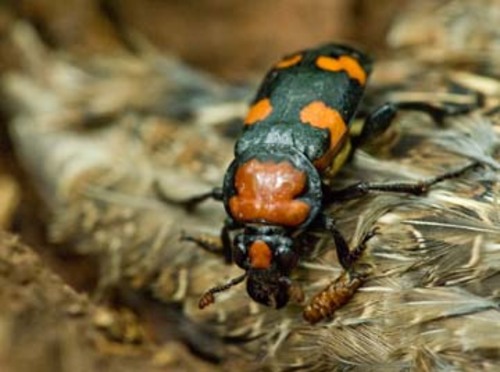
Photo by the U.S. Forest Service
On September 30, 2023, the U.S. District Court for the District of Columbia granted summary judgment in favor of the U.S. Fish and Wildlife Service (Service) in a case challenging the agency’s final rule downlisting the American burying beetle (Nicrophorus americanus) to “threatened species” status under the Endangered Species Act (ESA).
In its opinion, the court held that the Service adhered to a reasonable interpretation of the ESA and followed proper procedures when deciding to downlist the American burying beetle to threatened status despite noting climate change will pose foreseeable and grave risk to the beetle’s remaining populations in the coming decades.
In its motion for summary judgment, plaintiff Center for Biological Diversity (CBD) argued the Service violated the ESA because the agency relied on inadequate data in making its decision, and alleged it failed to issue regulations necessary to conserve the species under section 4(d) of the ESA. CBD asserted the Service’s downlisting determination contradicted evidence demonstrating that climate change is likely to impact the species over the next several decades due to higher temperatures and loss of available carrion, upon which the species depends throughout its life cycle.
The downlisting of the American burying beetle will remove protections automatically conferred to it when the Service listed the species as endangered in 1989. After the species’ initial listing, the Service developed a recovery plan for the American burying beetle with two objectives: (1) immediately halt the decline of beetles in their remaining habitats, and (2) “improve [the species’] status so that it could be reclassified from endangered to threatened.” The Service used a benchmark of self-sustaining wild populations of at least 500 adult beetles to determine whether a region’s population was under threat of extinction. A follow-up study in 2008 showed that beetle populations stabilized around that benchmark number, but the beetles’ habitats dwindled to pockets of the Northern Plains, Southern Plains, and a small area of New England.
The court’s opinion explains that, in 2015, private interest parties presented compelling commercial evidence to the Service indicating that the beetle’s populations were stable, or that the prior studies were inaccurately undercounting the beetles, so that the species could be delisted altogether. The court noted that this evidence prompted the Service to renew its American burying beetle study, and the Service produced a final report in 2019. This updated study found that the beetle’s populations were in better shape than the previous studies concluded. The Service also found that the two most significant factors for the species’ success or demise were “habitat impacts due to land use and effects related to climate change.”
Ultimately, the Service proposed downlisting the species based on the agency’s conclusion in its 2019 study that the “beetle’s viability is higher than was known at the time of listing” and “it is not presently in danger of extinction.” With respect to the “land use” drivers of the beetle’s habitat loss, the Service included section 4(d) protections prohibiting incidental takings throughout the beetle’s range (except for areas in the Southern Plains not included in special conservation zones). The court held the Service’s report was sufficiently detailed and specific, and it deferred to the Service’s reasoning that the likely occurrence of the American burying beetle’s extinction was “a period of 20 to 30 years away from its decision” such that the section 4(d) protections were adequate. The court also held that the Service satisfied its rulemaking obligations under the Administrative Procedure Act.
As a result of the court’s ruling, the American burying beetle’s threatened listing and associated section 4(d) rule remain in effect.
- Associate
John O'Meara handles matters concerning liability for environmental compliance issues and torts, including enforcement actions brought by the U.S. Environmental Protection Agency (EPA) and state or local regulators. He ...
Nossaman’s Endangered Species Law & Policy blog focuses on news, events, and policies affecting endangered species issues in California and throughout the United States. Topics include listing and critical habitat decisions, conservation and recovery planning, inter-agency consultation, and related developments in law, policy, and science. We also inform readers about regulatory and legislative developments, as well as key court decisions.
Stay Connected
 RSS Feed
RSS Feed
Categories
- Alternative Energy
- Bald and Golden Eagle Protection Act
- Budget
- CEQA
- CESA
- Climate Change
- Congress
- Conservation
- Construction Projects
- Consultation
- Continuing Education
- Court Decisions
- Critical Habitat
- Delisting
- Endangered Species Act
- Event
- Fish & Wildlife Service
- Freedom of Information Act
- Government Administration
- Legal
- Legislation
- Listing
- Litigation
- Migratory Bird
- National Marine Fisheries Service
- NEPA
- Off Shore Wind
- Pacific Northwest
- project
- Publications
- Regulatory Reform
- Sacramento-San Joaquin Delta
- SEPA
- Speaking Engagements
- Supreme Court
- Texas
- Timberland
- Water Issues

